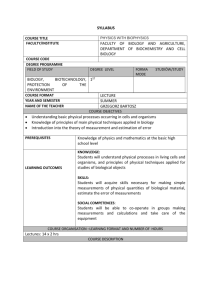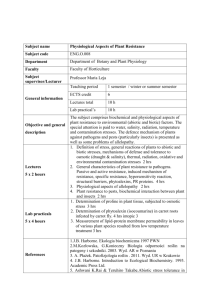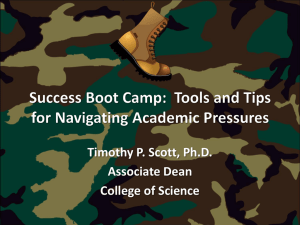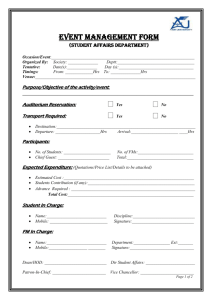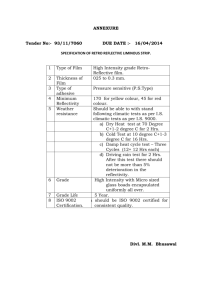chapter 9 solutions
advertisement
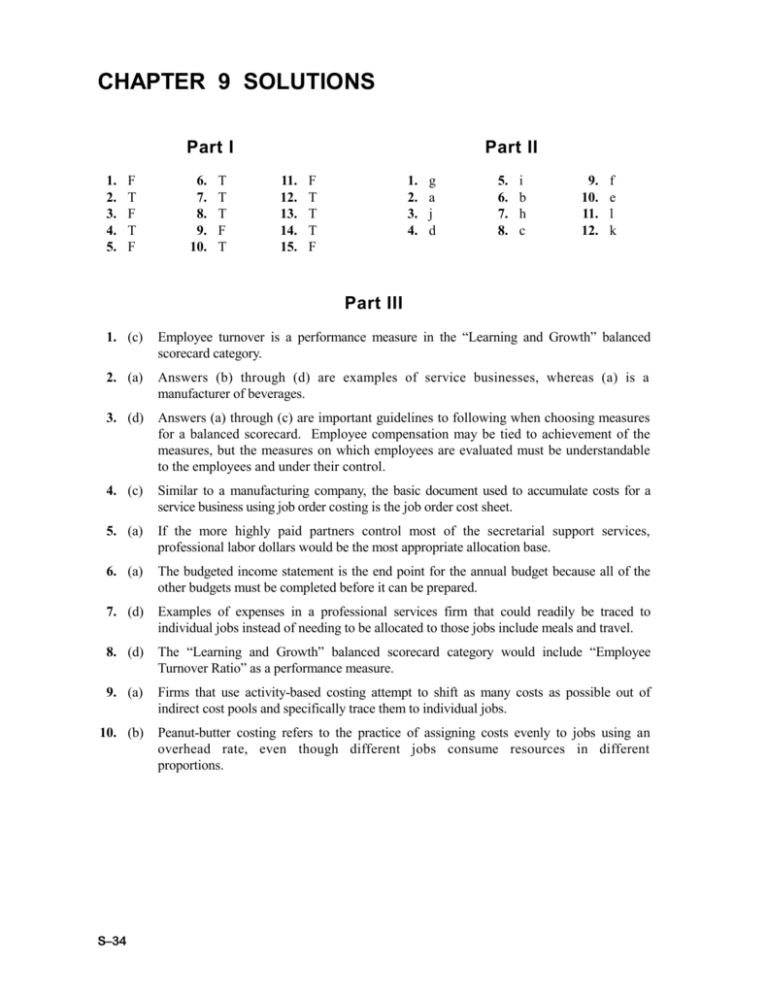
CHAPTER 9 SOLUTIONS Part I 1. 2. 3. 4. 5. F T F T F 6. 7. 8. 9. 10. T T T F T Part II 11. 12. 13. 14. 15. F T T T F 1. 2. 3. 4. g a j d 5. 6. 7. 8. i b h c 9. 10. 11. 12. f e l k Part III 1. (c) Employee turnover is a performance measure in the “Learning and Growth” balanced scorecard category. 2. (a) Answers (b) through (d) are examples of service businesses, whereas (a) is a manufacturer of beverages. 3. (d) Answers (a) through (c) are important guidelines to following when choosing measures for a balanced scorecard. Employee compensation may be tied to achievement of the measures, but the measures on which employees are evaluated must be understandable to the employees and under their control. 4. (c) Similar to a manufacturing company, the basic document used to accumulate costs for a service business using job order costing is the job order cost sheet. 5. (a) If the more highly paid partners control most of the secretarial support services, professional labor dollars would be the most appropriate allocation base. 6. (a) The budgeted income statement is the end point for the annual budget because all of the other budgets must be completed before it can be prepared. 7. (d) Examples of expenses in a professional services firm that could readily be traced to individual jobs instead of needing to be allocated to those jobs include meals and travel. 8. (d) The “Learning and Growth” balanced scorecard category would include “Employee Turnover Ratio” as a performance measure. 9. (a) Firms that use activity-based costing attempt to shift as many costs as possible out of indirect cost pools and specifically trace them to individual jobs. 10. (b) Peanut-butter costing refers to the practice of assigning costs evenly to jobs using an overhead rate, even though different jobs consume resources in different proportions. S–34 Chapter Nine Solutions Part IV 1. Henry and Jones Revenue Budget For the Year Ended December 31, 20-Item Professional Hours Billing Rate Total Revenues Partners............................. Associates ........................ Staff .................................. Total ............................. 4,000 7,000 11,000 22,000 $200 120 80 $ 800,000 840,000 880,000 $2,520,000 2. 3. 4. 5. Henry and JonesCowher Professional Labor Budget For the Year Ended December 31, 20-Item Professional Hours Wage Rate Total Labor Dollars Partners............................. Associates ........................ Staff .................................. Total ............................. 4,000 7,000 11,000 22,000 $100 60 40 $ 400,000 420,000 440,000 $1,260,000 Henry and Jones Overhead Budget For the Year Ended December 31, 20-Item Amount Secretarial Support........................................................ Fringe Benefits .............................................................. Depreciation—Building ............................................... Utilities .......................................................................... Depreciation—Equipment ............................................ Telephone/Fax............................................................... Photocopying ................................................................ Total .......................................................................... $230,000 190,000 90,000 43,000 40,000 31,000 22,000 $646,000 Henry and Jones Other Direct Expenses Budget For the Year Ended December 31, 20-Item Amount Travel ............................................................................ Meals ............................................................................. Total .......................................................................... $54,000 18,000 $72,000 Henry and Jones Budgeted Income Statement For the Year Ended December 31, 20-Revenues ....................................................................... $2,520,000 Operating Costs: Professional Labor ....................... $1,260,000 Overhead Support ........................ 646,000 Other Direct Expenses ................. 72,000 1,978,000 Operating Income.......................................................... $ 542,000 S–35 Solutions Chapter Nine Part V 1. Hartwell Industries Professional Labor Cost: 50 hrs. × $57.14* ....................................... 45 hrs. × $57.14 ......................................... Professional Support: 50 hrs. × $39.05** ..................................... 45 hrs. × $39.05 ......................................... Total ........................................................... James Kimmel $2,857 $2,571 1,953 $4,810 1,757 $4,328 Computations: ** ($125,000 ) + ($70,000 5) = $57.14 1,500 7 ** $410,000 = $39.05 10,500 hrs. 2. Hartwell Industries Professional Labor Cost: 10 hrs. × $83.33* ....................................... 30 hrs. × $83.33 ......................................... Associate Labor Cost: 40 hrs. × $46.67** ..................................... 15 hrs. × $46.67 ......................................... Litigation Support: $833 × $1.12*** ........................................ $2,500 × $1.12 ........................................... Secretarial Support: 50 hrs. × $12.38**** ................................. 45 hrs. × $12.38 ......................................... Total ........................................................... Computations: S–36 **** (2 $125,000) = $83.33 1,500 2 **** 5 $70,000 = $46.67 1,500 5 **** $280,000 = $1.12 (2 $125,000) **** $130,000 = $12.38 (7 1,500) James Kimmel $ 833 $2,500 1,867 700 933 2,800 619 $4,252 557 $6,557 Chapter Nine Solutions Part VI Performance Measure Financial Revenue from new products Customer satisfaction surveys Time from receipt of order to shipment Percentage of compensation based on team performance Percentage of employees trained in new processes Time taken to replace defective products Percentage of products returned Gross margin percentage Market share Percentage of defect-free units Number of employee suggestions Operating income Percentage of on-time deliveries Employee turnover ratio Return on investment Number of new customers X Customer Internal Business Processes Learning and Growth X X X X X X X X X X X X X X X S–37



